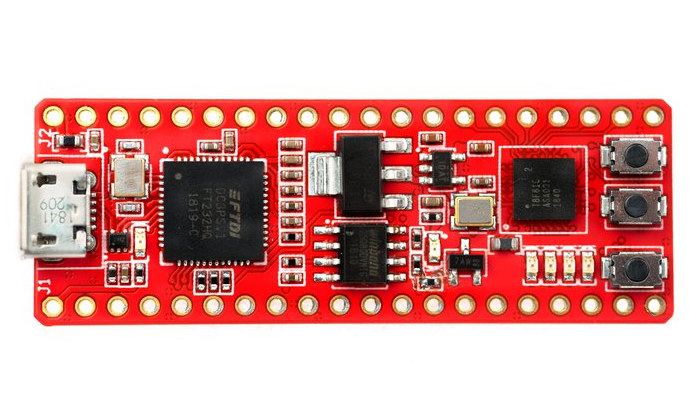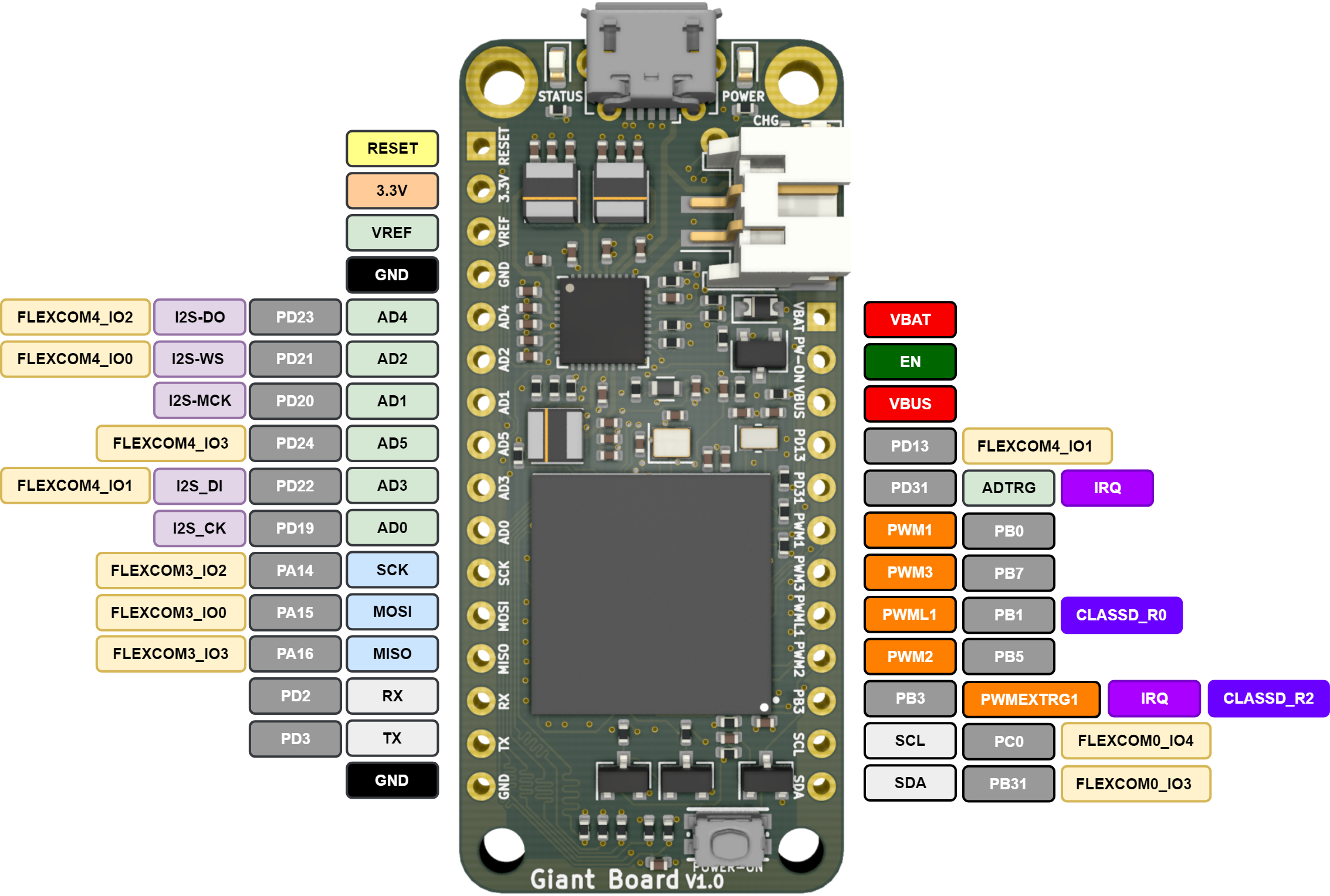Leon ANAVI is a software engineer with an interest in open-source hardware, and he had previously launched several ANAVI boards for home automation based on Espressif ESP8266 or for Raspberry Pi boards including ANAVI thermometer, ANAVI light controller, and ANAVI Infrared pHAT among others. Leon has now introduced a new board on Crowd Supply: ANAVI gas detector. The board is powered by ESP8266 WiSoC providing WiFI connectivity, and supports MQ gas sensor modules such as MQ-135, MQ-2, or MQ-3 in order to monitor air quality and detect gas leaks. ANAVI gas detector board specifications: Wireless Module – Based on ESP8266 Tensilica L106 32-bit processor with Wi-Fi 4 802.11 b/g/n connectivity Display – Optional Mini OLED display Gas sensor support – MQ-135 for air quality or any other 5V MQ analog gas sensor Expansion – 3x slots for I²C sensors Debugging / Programming – UART pins for flashing custom firmware Misc […]
$30 FireAnt Development Board Features Efinix Trion T8 FPGA (Crowdfunding)
When I think FPGA, company names such as Xilinx, Altera (now Intel), or even Microsemi come to my mind. But there are also other companies such as Anlogic or Lattice Semi that offer FPGA chips. Today I’ve come across another FPGA silicon vendor, namely Efinix, with their Trion T8 FPGA found in XIPS Technology’s tiny FireAnt development board targeting makers and hardware designers. FireAnt specifications: FPGA – Efinix Trion T8 (T8F81C2) with 7384x LE counts, 8x embedded multipliers, 1x low-power oscillator, 1x PLL, 122.88 kbit internal RAM; Package – BGA-81 (5×5 mm) Storage – 8 Mbit serial NOR Flash Expansion – 2x 20-pin headers (soldered or unpopulated) with up to 35 GPIOs Debugging & Programming Micro USB 2.0 port via FTDI FT232HQ USB to serial chip JTAG signals in bottom layer Misc – Onboard 33.333 MHz crystal oscillator for PLL; 6x LEDs including 4 user configurable; 3x buttons (Reset, BTN1, […]
PiJuice Zero a UPS for the Raspberry Pi Zero (Crowdfunding)
Made to work with the Raspberry Pi Zero, the PiJuice Zero is an Uninterruptable Power Supply (UPS) and project platform board, that can fit inside the Pi Zero case. The latest innovation from the tech gurus at Pi Supply, the PiJuice Zero is easy to use and quite powerful. The original product was the PiJuice HAT which was released in 2016. The rundown on this platform and the crowdfunding page can be found on Crowd Supply. The PiJuice Zero allows users to take their Raspberry Pi Zero projects anywhere and still keep things running, while intelligent power management controls how that power is utilized. The user-friendly software, programmable LEDs and switches allow for maximum options in applications. The PiJuice Zero was made for those in-the-field projects. Completely wireless and off-the-grid power supply the PiJuice Zero is packed with features and allows for applications for the Raspberry Pi Zero, that couldn’t […]
Microchip SAMA5 based Giant Board Launched on Crowd Supply for $50 and Up
Earlier this year we gave you details about some new development board, most especially about the Giant board. A tiny single board computer that runs Linux on Arm Cortex-A5 processor. This super tiny single-board computer (SBC) is based on the Adafruit Feather form factor. Unlike its name, the giant board is actually a small microchip. And it packs an awful lot of power for its size. The news is that it has launched on Crowd Supply for $50 and up. In addition, the giant board implements the power of size, which makes it unique. It squeezes SBC into a package the size of a microcontroller board. This will in turn relax memory, storage, and processing constraints. Consequently allowing you to effectively work on your projects. Another thing to know about the Giant Board is that it runs full Debian Linux. Giving developers and users access to an endless number of […]
Obsidian ESP32 Board Follows Raspberry Pi Model A Form Factor (Crowdfunding)
When Thomas McKahan had been playing with ESP32 for a while, he found the need to use Raspberry Pi HAT boards and enclosure with his new hardware, so he went ahead and designed his own ESP32 board compatible with Raspberry Pi accessories, and following the smaller Raspberry Pi Model A / 3 Model A+ form factor. Obsidian ESP32 specifications: Wireless module – Espressif Systems ESP32-WROVER-B 802.11 b/g/n WiFi + Bluetooth 4.2 / BLE module with 16 MB flash, 8 MB PSRAM USB – 1x micro USB port for power and programming Audio – 3.5mm TRS audio jack connected to ESP32 DACs Expansion 40-pin GPIO header compatible with popular HAT expansion boards with 3.3 V signalling, I²S for audio DAC, I²C and SPI, Serial UART available on header or via microUSB, I²C GPIO expander with interrupts & address selection 8-pim unpopulated header from remaining I/Os accessible through GPIO expander 5-pin unpopulated […]
REFLO Air is a $200 Open Source Hardware Portable PCB Reflow Machine (Crowdfunding)
While possible, it can be challenging to solder SMD components with a soldering iron or a heat gun, and going with a reflow oven is much easier and normally yields better results. But reflow ovens are usually fairly bulky, and somewhat expensive. MagixBox’ REFLO Air PCB reflow machine is much more compact making it more portable, open source hardware, and affordably priced since the early bird pledge starts at $199 on Crowd Supply. REFLO Air specifications: Control panel with LCD segment display and buttons Heat Control 100-300°C temperature control K-type thermometer Cooling fan Power Supply-110V-220VAC Max Power – 200 Watts Dimensions – 138 x 138 x 51 mm Weight – 900 g The company also offers optional accessories for its PCB reflow machine with a 3D-printed phone holder to use the phone’s camera to magnify the reflow area, a mini vice made of aluminum, and a semi-automated XY table. The […]
Onion Omega2 LTE Board Combines WiFi, 4G LTE and GNSS Connectivity (Crowdfunding)
Onion has launched several compact OpenWrt WiFi boards for IoT projects over the years starting with their Onion Omega board in 2015, and the latest so far being Onion Omega2 Pro with a massive 8GB storage. The company has now launched a new model with 4G LTE connectivity called Onion Omega2 LTE, based on Omega2S+ module, and also featuring GNSS global satellite positioning capability. Onion Omega2 LTE specifications: WiFi Module – Onion Omega2S+ IoT computer module with MediaTek MT7688 MIPS CPU @ 580 MHz, 128 MB RAM, 32 MB storage Cellular and GNS Module – Quectel EC25 LTE Cat 4 modem that delivers 150 Mbps downlink and 50 Mbps uplink data rates, provided either for North America or global markets External Storage – MicroSD card slot up to 2 TB (once such cards become available…) Connectivity 2.4 GHz 802.11 b/g/n Wi-Fi 4 + onboard 2 dBi direction chip antenna & […]
Programmable-Air is an Arduino Nano Powered Pneumatics Kit (Crowdfunding)
Programmable-Air is a hardware toolkit that allows you to inflate and deflate objects. Powered by an Arduino Nano board, the kit comes with high pressure and vacuum pumps, valves, and a pressure sensor that enables users to experiement and learn about pneumatics and inflatables. Some of the potential applications include vacuum pick and place machines, soft robots able to walk, soft robotics hands, using a syringe as a linear actuator, inflatable bras, arts projects and more. Programmable-Air specifications: MCU Board – Arduino Nano board based on Microchip ATMega328P microcontroller Pneumatics – Full channel control, i.e. high pressure through atmospheric pressure to vacuum output in the same tube. Max pressure – 0.5 atmosphere (7.5 PSI / 50 kPa) Min Pressure – -0.5 atmosphere (-7.5 PSI / -50 kPa) Flow rate: 2 liters per minute per motor Expansion Grove I²C connector to easily add sensors (Not shown in prototype photo above) Expandable […]










